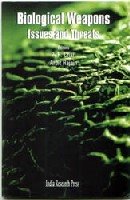 ISBN: 9812104046
ISBN: 9812104046This book published by the Indian Research press, has been edited by P.R. Chari and Arpit Rajain. Before I move on to the book, I would like to mention a few words about the editors as given in the book. P.R. Chari is a former member of Indian Administrative Services and has also served in the Ministry of Defense. He has worked extensively on Nuclear disarmament and non-proliferation. Arpit Rajain has been working as a Research Officer in the Institute of Peace and Conflict studies since 1997 on Weapons of Mass Destruction (WMD) issues.
This book appears to be a collection of articles, research papers and essays which cover various aspects of Biological and Chemical Weapons. We all know that use of Biological and Chemical Weapons (BCW) is nothing new especially in India where it has found mention even in the ancient texts. But in today’s scenario there is common global enemy which is stateless and which does not fight war from the front (like in the battlefield). Yes, I am talking about terrorism. After the September 11 attacks, the London bombings, the recent Mumbai blasts and various other events, it is clear that the terrorists will stop at nothing and will make every possible effort to cause terror and pain. Every time they strike, they strike with all that they have got and cause massive damage by attacking innocent civilians. So if terrorists are able to acquire WMDs they can create havoc and bloodbath.
Set on a similar note the book tells that the BCWs are the most dangerous of the WMD club for fairly simple reasons:
While these and MANY other points are discussed in the later chapters of the book, the initial chapters talk about Chemical Weapons Convention (CWC) and Biological Weapons Convention (BWC). It talks about the various treaties signed by the developed countries to set certain norms for regulation of BCWs and they all are incomplete in some or the other way. While the initial chapter can get difficult to comprehend for a reader who is new to the subject, the later chapters are a good read.
I would highly recommend the book if you are interested in the subject of bio-warfare and weaponry and its implications now when a new challenge has emerged.



No comments:
Post a Comment